HLTAAP001 Recognise healthy body systems
{`
CHC33015 Certificate III in Individual Support (Ageing)
Advance College
`}
This Student Assessment Booklet includes all your tasks for assessment of HLTAAP001 Recognise healthy body systems.
ABOUT YOUR ASSESSMENTS
This unit requires that you complete 4 assessment tasks. You are required to complete all tasks to demonstrate competency in this unit.
|
Assessment Task |
About this task |
|
Assessment Task 1: Written questions |
You must correctly answer all questions to show that you understand the knowledge required of this unit. |
|
Assessment Task 2: Case study |
You are to read the case study and complete the questions. |
|
Assessment Task 3: Project – information brochure |
You are develop an information brochure about maintaining a healthy body. |
|
Assessment Task 4: Workplace project |
You need to complete this task in your workplace. You will need to: obtain information about physical health status of a client participate in a physical health check (or observe one being undertaken) identify variations from normal health gather suitable health information to share with others. |
QUESTION 1
- Draw an arrow to identify the parts of the cardiovascular system to their location on the diagram. Aorta
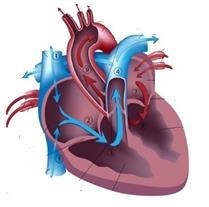
Left atrium
Left ventricle
Right ventricle
Right atrium
Pulmonary veins
Pulmonary arteries
Inferior vena cava
Superior vena cava
- Refer to the diagram above of the cardiovascular system and explain how blood flows through the heart.
- Describe the functions of the cardiovascular system.
2
- Draw an arrow to identify the parts of the respiratory system to their location on the diagram.
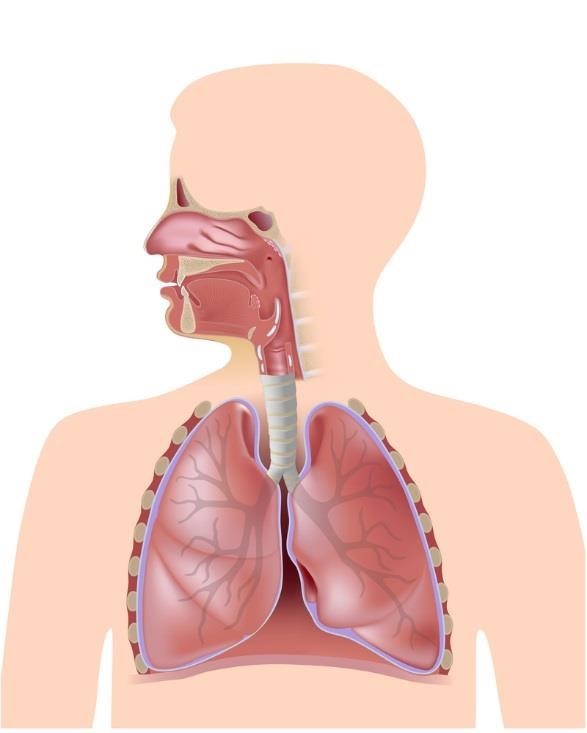
Nasal cavity
Pharynx
Larynx
Trachea
Right lung
Right main bronchus
Bronchiole
Pleura
- Describe the functions of the respiratory system.
3
- Identify the three main parts of the muscular system and briefly explain the purpose of each.
|
1. |
|
2. |
|
3. |
- Identify the two main parts of the skeletal system.
|
1. |
|
2. |
- Describe the functions of the musculoskeletal system.
4
- a) Identify where each of the following glands from the endocrine system are located and briefly explain the purpose of each.
- Hypothalamus
- Pituitary gland
- Thyroid gland
- Parathyroid glands
- Adrenal glands
- Pineal gland
- Reproductive glands
- Pancreas
Describe the function of the endocrine system.
QUESTION 5
- a) Identify the two parts of the nervous system and briefly explain their function.
|
1. |
|
2. |
Describe the function of the nervous system.
QUESTION 6
- a) Draw an arrow to identify the parts of the digestive system to their location on the diagram.
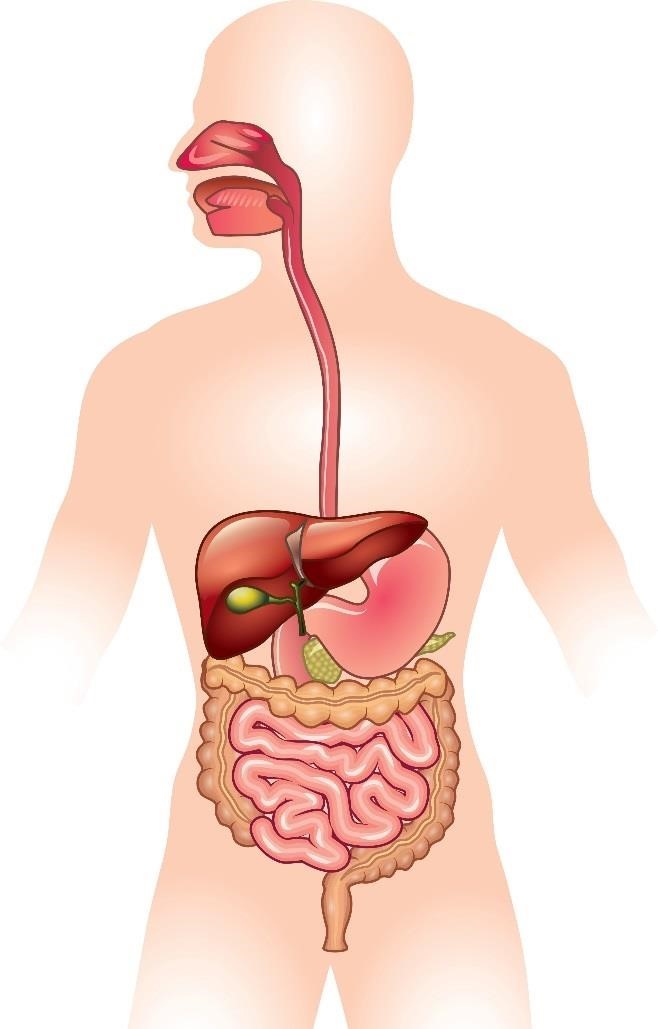
Oesopagus
Liver
Stomach
Gall bladder
Duodenum
Jejunum Ileum
Colon
Rectum
Anus
Describe the function of the digestive system, including how waste is removed from the body.
QUESTION 7
- a) Identify the four main parts of the urinary system and provide a brief explanation of the function of each.
|
1. |
|
2. |
|
3. |
|
4. |
Describe the function of the urinary system as a whole, including its role in regulating fluid and electrolyte balance in the body.
QUESTION 8
- Identify the five main parts of the female reproductive system and provide a brief explanation of their function.
|
1. |
|
2. |
|
3. |
|
4. |
|
5. |
- Identify the three main parts of the male reproductive system and provide a brief explanation of their function.
|
1. |
|
2. |
|
3. |
- Describe the function of the human reproductive system.
QUESTION 9
- Provide a definition of the integumentary system and explain its function.
- Identify the three layers of tissue of human skin.
|
Top layer | |
|
Middle layer | |
|
Deepest layer |
- Draw an arrow to identify the parts of the integumentary system to their location on the diagram
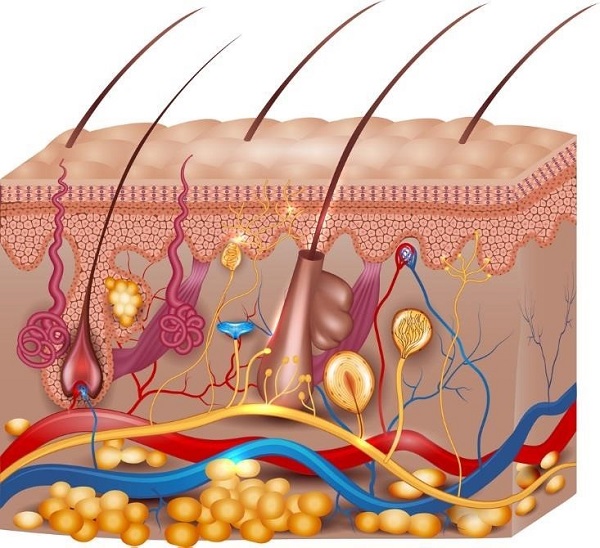
Hair
Epidermis
Sebaceous gland
Sweat gland duct
Dermis
Subcutaneous layer
Nerve
Touch receptor
QUESTION 10
Describe the function of the lymphatic system. In your response, identify the six lymphatic organs.
QUESTION 11
Describe in one paragraph each how each of the following functions occurs in the human body. a) Smell
- Taste
- Vision
- Equilibrium
- Hearing
QUESTION 12
- Provide a definition of ’cells’.
|
A. | |
|
B. | |
|
C. | |
|
D. | |
|
E. | |
|
F. | |
|
G. | |
|
H. | |
|
I. | |
|
J. | |
|
K. | |
|
L. | |
|
M. | |
|
N. | |
|
O. | |
|
P. | |
|
Q. | |
|
R. | |
|
S. |
- Identify the components of a cell as shown in the figure below:
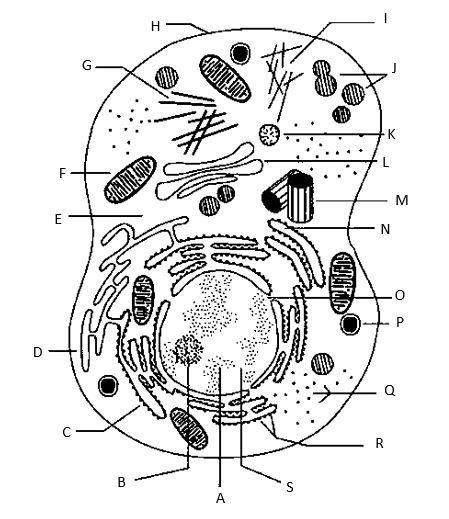
- Explain the function of the following:
|
Mitochondria | |
|
Ribosomes | |
|
Golgi apparatus | |
|
Nucleus | |
|
Lysosomes | |
|
Endoplasmic reticulum (smooth and rough) |
- Provide a definition of human body tissue. In your answer, identify the four principal types of tissue and briefly explain their function.
- Identify the 11 major organ systems of the human body.
|
1. |
|
2. |
|
3. |
|
4. |
|
5. |
|
6. |
|
7. |
|
8. |
|
9. |
|
10. |
|
11. |
QUESTION 13
- Explain how food and nutrition affect health and contribute to a healthy body.
- In the following table, explain the purpose of each food type and what foods or other locations it may be obtained from.
|
Food type |
Purpose |
Where it may be obtained |
|
Protein | ||
|
Carbohydrate | ||
|
Fat | ||
|
Vitamin A | ||
|
Vitamin B1 (Thiamine) |
|
Food type |
Purpose |
Where it may be obtained |
|
Vitamin B12 | ||
|
Vitamin C | ||
|
Vitamin D | ||
|
Vitamin K | ||
|
Sodium |
|
Food type |
Purpose |
Where it may be obtained |
|
Potassium | ||
|
Calcium |
QUESTION 14
List 10 recommendations you would make to an older person to maintain their body as healthily as possible (assume they have no medical conditions).
|
1. | |
|
2. | |
|
3. | |
|
4. | |
|
5. | |
|
6. | |
|
7. | |
|
8. | |
|
9. | |
|
10. |
QUESTION 15
- In the following table, provide a definition for each health terminology term.
|
Terminology |
Definition |
|
Analgesic | |
|
Anorexia | |
|
Arthritis | |
|
Breakthrough pain | |
|
Catheter | |
|
Diuretic | |
|
Dyspraxia | |
|
Terminology |
Definition |
|
Hallucination | |
|
Infarction | |
|
Prosthesis | |
|
Scabies | |
|
Thrombosis |
- Explain the difference between ‘contagious’ and ‘infectious’.
QUESTION 16
- Explain how the cardiovascular and respiratory system work together to ensure healthy body function.
- Explain how the integumentary and nervous system work together to ensure healthy body function.
QUESTION 17
- Describe the function of the immune system.
- The immune system is broken up into two parts – the innate system and the adaptive immune system. In the following table describe each of these systems.
|
Innate system | |
|
Adaptive immune system |
- Provide a brief definition of immunodeficiency.
- List four external methods of protecting the body from infection.
|
1. |
|
2. |
|
3. |
|
4. |
- List four healthy living strategies to help improve the immune system.
|
1. |
|
2. |
|
3. |
|
4. |
QUESTION 18
- Explain how the body maintains its temperature when the outside atmosphere is hot.
- Explain how the body maintains its temperature when the outside atmosphere is cold.
QUESTION 19
Ray has high blood pressure. His doctor is mindful that high blood pressure may lead to stroke or heart attack. Ray is a long-term smoker and also needs to lose around 15 kilograms.
- List six pieces of advice that the doctor should give Ray to help him manage his high blood pressure (hypertension)
|
1. |
|
2. |
|
3. |
|
4. |
|
5. |
|
6. |
- Imagine you are Ray’s carer. Locate some information from reputable sources (for example, government health websites, the Heart Foundation, your own local GP, brochures, fact sheets, articles, etc) that you could provide to Ray to help him maintain his blood pressure and keep his body healthy. Try to find at least three pieces of information.
Attach any hard copy documents to this assessment. If you have used websites, print out the pages or provide the weblinks so your assessor can check them.
Weblinks (if applicable):
- What symptoms are experienced by a person who has low blood pressure (hypotension)? What blood pressure reading is considered to be low?
- Imagine Ray had low blood pressure. List three pieces of advice that the doctor could give Ray to help him manage it.
|
1. |
|
2. |
|
3. |
QUESTION 20
- Briefly explain the difference between active and passive physical activity.
- Briefly explain range of motion (ROM) exercises and how they can improve joint function.
|
What do I need to hand in for this task? |
Have I completed this? |
|
Your answers to each question |
o |
ASSESSMENT TASK 2: CASE STUDY
TASK SUMMARY:
You are to read the case study and complete the questions.
WHAT DO I NEED IN ORDER TO COMPLETE THIS ASSESSMENT?
- Access to textbooks and other learning materials
- Access to a computer and the Internet (if you prefer to type your responses).
WHEN DO I DO THIS TASK?
- You will do this task in the classroom or as homework – your assessor will advise.
- Write in the due date as advised by your assessor: ___
WHAT DO I NEED TO DO IF I GET SOMETHING WRONG?
If your assessor marks any of your answers as incorrect, they will talk to you about resubmission. You will need to do one of the following:
- Answer the questions that were incorrect in writing.
- Answer the questions that were incorrect verbally.
|
CASE STUDY:JEMIMA |
|
Jemima comes to see you to ask advice. Her mother has recently died of complications from type 2 diabetes. Jemima is now worried about her risk of becoming diabetic. You ask for the history of the mother’s illness and find out the following: Her mother developed diabetes in her early 50s. She never managed to control her blood sugar levels. She was obese and lived a sedentary life. She developed heart disease in her 60s and died at 65. You then find out some information about Jemima: She is 35 Her blood pressure is 125/84 Her height is 1.63 m Her weight is 67kg She used to smoke but quit three years ago. She tries to eat a healthy diet but often needs to eat takeaway (up to five times a week) as she is very busy She has trouble sleeping and sometimes only gets around six hours a night She rarely exercises. |
- Explain the connection between diabetes and heart disease.
- Identify Jemima’s risk factors for Type 2 Diabetes.
- Looking at Jemima’s blood pressure, explain what you would recommend to her for healthy body functioning.
- Looking at Jemima’s height and weight, explain what you would tell her and recommend to her regarding healthy body function.
(Use the BMI calculator at http://www.betterhealth.vic.gov.au/bhcv2/bhcsite.nsf/pages/bmi)
- List three ‘tips’ you would give to Jemima to improve her eating of healthy foods on busy days.
- Based on the information above and the recommendations you have provided, now locate some information from reputable sources that you could provide to Jemima to help her maintain healthy body functioning. The information should address:
- Information about diabetes
- Maintaining good blood pressure
- Exercise (passive and active)
- Healthy eating Sleep.
Try to find at least two pieces of good, current information about each topic (preferably different to those you located for Ray in Assessment Task 1).
Attach any hard copy documents to this assessment. If you have used websites, print out the pages or provide the weblinks so your assessor can check them.
Weblinks:
|
What do I need to hand in for this task? |
Have I completed this? |
|
Your answers to this case study |
o |
ASSESSMENT TASK 3: PROJECT
TASK SUMMARY:
You are to prepare an information brochure on maintaining a healthy body for either:
- older persons OR
- people with a disability.
WHAT DO I NEED IN ORDER TO COMPLETE THIS ASSESSMENT?
- Access to textbooks and other learning materials
- Access to a computer and the Internet
- Access to a printer (if using a computer to create your brochure)
- Paper, pens etc (if drawing/writing your brochure)
WHEN DO I DO THIS ASSESSMENT?
- You will do this task in the classroom or as homework – your assessor will advise.
- Write in the due date as advised by your assessor: ___
WHAT DO I NEED TO DO IF I GET SOMETHING WRONG?
If your assessor sees that you have not completed any of the required sections of the brochure, or have provided incorrect information, or not provided your sources of information, they will give you some feedback and you will need to fix the errors and resubmit.
INSTRUCTIONS:
For this task you must prepare an information brochure for clients about maintaining a healthy body.
You need to choose one target audience:
- Older persons OR
- People with a disability.
Your brochure must be no less than two A4 pages long. You may like to add pictures and diagrams to make it more engaging and interesting, and to help your target audience understand the information you are providing.
You can add pictures and diagrams if you like.
You can create your brochure by:
- using a computer and printing out a copy writing/drawing on paper.
Your brochure must include the following sections:
- Diet:
- Common dietary problems in older people or people with disabilities
- Common health problems caused by poor diet and how these health problems impact the healthy functioning of the major body systems
- Support that can be provided to encourage a healthy diet.
- Exercise:
- Common barriers to exercise in older people or people with a disability
- Common health problems caused by lack of exercise and how these impact the healthy functioning of the major body systems
- Support that can be provided to encourage healthy exercise – including use of both active and passive exercise.
- Emotional wellbeing:
- Common causes of wellbeing issues in older people or people with a disability
- Effect of emotional and psychological problems on the healthy functioning of the major body systems – Support that can be provided to improve emotional wellbeing.
|
What do I need to hand in for this task? |
Have I completed this? |
|
Your completed information brochure |
o |
|
Sources you used to create your brochure |
o |
ASSESSMENT TASK 4: WORKPLACE PROJECT
There are four parts to this project:
- Part A: Obtain information about the physical health status of two different clients
- Part B: Observe a physical health check and document findings
- Part C: Identify and document variations from normal health
- Part D: Gather health information that could be shared with others.
WHAT DO I NEED IN ORDER TO COMPLETE THIS ASSESSMENT?
- Approval from your supervisor to work with two clients (under supervision)
- Access to workplace policies and procedures
- Access to each client’s medical information/care plan
- Access to a colleague who can undertake physical health checks in your presence
- Journal (provided)
- Supervisor Permission Form (provided) Client Permission Forms (provided).
WHEN DO I DO THIS TASK?
- You will do this task in your workplace.
- Write in the due date as advised by your assessor: ___
WHAT DO I NEED TO DO IF I GET SOMETHING WRONG?
If your assessor identifies that you did not complete all parts of your journal or did not get your supervisor’s sign off, you will be asked to fix the errors and resubmit.
INSTRUCTIONS:
You will need to complete this task in your workplace.
You will need to choose two different clients to work with. Talk to your supervisor for advice as to which clients might be appropriate for this task. You must obtain permission from your supervisor and each client to participate in the task – see the permission forms provided at the end of this task.
You will work with your clients and a colleague (or your supervisor if applicable) by going through Parts A–D.
Make two copies of each journal template (see the end of this task) – one for each client.
Note: Please do not identify your clients by name – you should refer to each client as ‘the client’ or ‘Client 1’ and ‘Client 2’ than use their name.
You should conduct this task twice, working with each client separately.
You must get each part of your journals signed by your supervisor before you submit them for assessment.
PART A:OBTAIN INFORMATION ABOUT THE PHYSICAL HEALTH STATUS OF CLIENTS
For this part of the task you are required to:
- Refer to your client’s medical information/care plan to familiarise yourself with their health background.
- Ask your client how they are feeling today – do they have any issues they would like to discuss?
- Discuss findings with the staff member supervising this task and identify any actual or potential health problems.
- Identify which body systems are involved and how these problems may affect the body’s overall functioning.
- Record your findings in the Part A template of your journal (see the template at the end of this task).
PART B:PHYSICAL HEALTH CHECKS
Observe the following physical health checks being performed by a qualified member of staff. The physical health checks will need to be performed on both clients you spoke to in Part A above.
Health checks must include:
- Temperature
- Pulse
- Respiration
- Blood pressure
- Bowels opened
- Client-specific observations as applicable (for example, blood sugar test, visual observation, weight check, check of ankles for swelling, etc).
Make a record of the findings in your journal in the Part B template.
PART C:IDENTIFY VARIATIONS FROM NORMAL HEALTH
Using the information you have gathered in Part A and Part B, interpret it and answer the two questions in the journal in the Part C template.
PART D:GATHER INFORMATION TO SHARE WITH OTHERS
Based on the health information you gathered during this task for each client, gather some information (fact sheets, brochures, websites etc) that you could potentially give each client to help them maintain good health, and other colleagues in the workplace so they can promote healthy body function.
You may be able to locate good information within your workplace, at the local GP or health centre, on the Internet and so on.
Write down the information you gathered in your journal in the Part D template, and show the information to your supervisor. They will sign Part D of your template to indicate that the information you gathered was relevant to the needs of the client, and it would be suitable to share with others.
|
What do I need to hand in for this task? |
Have I completed this? |
|
Completed journal for client 1 with supervisor sign off |
o |
|
Completed journal for client 2 with supervisor sign off |
o |
|
ASSESSMENT TASK 4 – PERMISSION FORM |
|
Supervisor’s permission – Client 1 I, ______ , <Supervisor’s name> approve _____________________ <student’s name> to undertake this project with __ <Client’s name>. The student will perform the following tasks: obtain information about the physical health status of the client observe a physical health check observe a physical health check conducted by a qualified member of staff gather suitable health information that can be shared with the client and others. Approval is dependent on the following conditions: The student must be supervised at all times when working with the client. The client or their family may request that this project be stopped at any point. In this case, other arrangements will be made in consultation with the student, the student’s assessor and myself. Supervisor’s name: _____ Signature: _______ Date: ______ |
|
ASSESSMENT TASK 4 – PERMISSION FORM |
|
Supervisor’s permission – Client 2 I, ______ , <Supervisor’s name> approve _____________________ <student’s name> to undertake this project with __ <Client’s name>. The student will perform the following tasks: obtain information about the physical health status of the client observe a physical health check observe a physical health check conducted by a qualified member of staff gather suitable health information that can be shared with the client and others. Approval is dependent on the following conditions: The student must be supervised at all times when working with the client. The client or their family may request that this project be stopped at any point. In this case, other arrangements will be made in consultation with the student, the student’s assessor and myself. Supervisor’s name: _____ Signature: _______ Date: ______ |
|
ASSESSMENT TASK 4 – PERMISSION FORM |
|
Client 1 permission I, ______ , <client name> approve __ <student’s name> to undertake this project, which will involve access to my health information and observations of health checks being performed on myself by a member of staff. The student will perform the following tasks: obtain information about my physical health status, using questioning, my care plan or other relevant health information observe a qualified member of staff conducting a physical health check discuss and identify variations from normal health gather information that may be provided to myself and others in the workplace regarding healthy body functioning. My permission is dependent on the following conditions: The student will be supervised at all times. I may request that this project be stopped at any stage. Client name: ____ Signature: _______ Date: ______ |
|
ASSESSMENT TASK 4 – PERMISSION FORM |
|
Client 2 permission I, ______ , <client name> approve __ <student’s name> to undertake this project, which will involve access to my health information and observations of health checks being performed on myself by a member of staff. The student will perform the following tasks: obtain information about my physical health status, using questioning, my care plan or other relevant health information observe a qualified member of staff conducting a physical health check discuss and identify variations from normal health gather information that may be provided to myself and others in the workplace regarding healthy body functioning. My permission is dependent on the following conditions: The student will be supervised at all times. I may request that this project be stopped at any stage. Client name: ____ Signature: _______ Date: ______ |
|
ASSESSMENT TASK 4: WORKPLACE PROJECT – JOURNAL |
|
Complete this journal for the client you have chosen to work with. Make sure you get your supervisor to sign off each entry. Note: to preserve confidentiality, you must not include any information that could identify your client. Use ‘the client’ rather than the client’s name. |
|
PART A: OBTAIN INFORMATION ABOUT PHYSICAL HEALTH STATUS OF CLIENTS (CLIENT 1) | ||
|
Date Part A was undertaken: | ||
|
Comments |
Supervisor initials | |
|
Describe the information that you learned about your client’s physical health status by reviewing their medical record/care plan. |
|
Describe the information you gathered from your client. How are they feeling today – do they have any issues? | ||
|
Discuss with the person supervising this task - what actual or potential health problems does your client have? | ||
|
What body systems are involved with your client’s issues? How might these problems affect the overall functioning of your client’s body? |
|
PART B: PHYSICAL HEALTH CHECKS (CLIENT 1) | |||
|
Date Part B was undertaken: | |||
|
Recordings |
Supervisor initials | ||
|
Record the client’s physical health indicators. If any of these are not applicable, mark as N/A. |
Temperature | ||
|
Pulse | |||
|
Respiration | |||
|
Blood pressure | |||
|
Bowels opened | |||
|
Client-specific observations | |||
|
PART C: IDENTIFY VARIATIONS FROM NORMAL HEALTH (CLIENT 1) | |||
|
Interpret the information you obtained in Part A and Part B and answer the following questions. | |||
|
Recordings |
Supervisor initials | ||
|
Does your client have any indicators that there is a variation from normal health? Explain your answer and discuss the body systems involved that a contributing to a variation in healthy functioning. | |||
|
How will this information be shared? | |||
|
I confirm that the student’s journal is an accurate account. | |||
|
Supervisor name: | |||
|
Supervisor signature: |
Date: | ||
|
PART D: GATHER INFORMATION TO SHARE WITH OTHERS (CLIENT 1) | ||
|
Based on the information you have gathered about each client, document here the sources/information that you have gathered that you would potentially share with your clients and others in the workplace. | ||
|
Information for Client 1: | ||
|
Information for Client 2: | ||
|
I confirm that the information gathered by the student was relevant to the needs of each client and from current and reputable sources, and could be provided to both clients and staff to keep them educated and aware of the importance of healthy body functioning. | ||
|
Supervisor name: | ||
|
Supervisor signature: |
Date: | |
|
ASSESSMENT TASK 4: WORKPLACE PROJECT – JOURNAL (CLIENT 2) |
|
Complete this journal for the client you have chosen to work with. Make sure you get your supervisor to sign off each entry. Note: to preserve confidentiality, you must not include any information that could identify your client. Use ‘the client’ rather than the client’s name. |
|
PART A: OBTAIN INFORMATION ABOUT PHYSICAL HEALTH STATUS OF CLIENTS (CLIENT 2) | ||
|
Date Part A was undertaken: | ||
|
Comments |
Supervisor initials | |
|
Describe the information that you learned about your client’s physical health status by reviewing their medical record/care plan. |
|
Describe the information you gathered from your client. How are they feeling today – do they have any issues? | ||
|
Discuss with the person supervising this task - what actual or potential health problems does your client have? | ||
|
What body systems are involved with your client’s issues? How might these problems affect the overall functioning of your client’s body? |
|
PART B: PHYSICAL HEALTH CHECKS (CLIENT 2) | |||
|
Date Part B was undertaken: | |||
|
Recordings |
Supervisor initials | ||
|
Record the client’s physical health indicators. If any of these are not applicable, mark as N/A. |
Temperature | ||
|
Pulse | |||
|
Respiration | |||
|
Blood pressure | |||
|
Bowels opened | |||
|
Client-specific observations | |||
|
PART C: IDENTIFY VARIATIONS FROM NORMAL HEALTH (CLIENT 2) | |||
|
Interpret the information you obtained in Part A and Part B and answer the following questions. | |||
|
Recordings |
Supervisor initials | ||
|
Does your client have any indicators that there is a variation from normal health? Explain your answer and discuss the body systems involved that a contributing to a variation in healthy functioning. | |||
|
How will this information be shared? | |||
|
I confirm that the student’s journal is an accurate account. | |||
|
Supervisor name: | |||
|
Supervisor signature: |
Date: | ||
|
PART D: GATHER INFORMATION TO SHARE WITH OTHERS (CLIENT 2) | ||
|
Based on the information you have gathered about each client, document here the sources/information that you have gathered that you would potentially share with your clients and others in the workplace. | ||
|
Information for Client 1: | ||
|
Information for Client 2: | ||
|
I confirm that the information gathered by the student was relevant to the needs of each client and from current and reputable sources, and could be provided to both clients and staff to keep them educated and aware of the importance of healthy body functioning. | ||
|
Supervisor name: | ||
|
Supervisor signature: |
Date: | |


